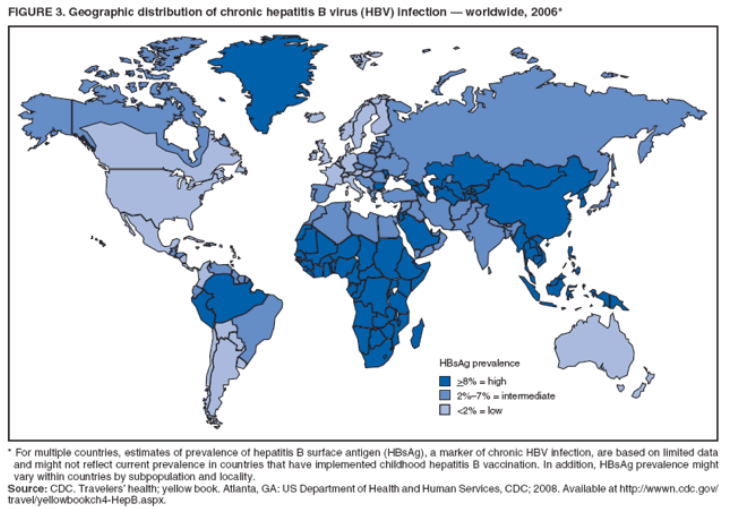Hepatitis B epidemiology and demographics
|
Hepatitis B |
|
Diagnosis |
|
Treatment |
|
Case Studies |
|
Hepatitis B epidemiology and demographics On the Web |
|
American Roentgen Ray Society Images of Hepatitis B epidemiology and demographics |
|
Risk calculators and risk factors for Hepatitis B epidemiology and demographics |
Editor-In-Chief: C. Michael Gibson, M.S., M.D. [2]
Overview
Chronic Hepatitis B (HBV) is a major global health problem. According to the World Health Organization (WHO), more than 2 billion people have been infected with HBV. It is a major cause of chronic liver disease worldwide, affecting an estimated 1.25 million persons in the U.S., and more than 240 million people world wide.[1] [2]
Prevalence
Worlwide, the prevalence rate of HBV ranges from a low of <2% in developed countries to a high of <8% in developing countries.[3] The prevalence is lowest in countries with the highest standards of living, such as Great Britain, Canada, United States, Scandinavia, and some other European Nations.[4] Regions with the highest prevalence of HBV include Sub-Saharan Africa and East Asia. The infection is usually acquired during childhood in these regions. Higher rates of chronic HBV is also found in southern parts of Eastern and Central Europe, the Amazon, the Middle East, and India. An estimated 2-5% of the population in the Middle East and Indian subcontinent is chronically infected.[1] The prevalence of HBV is decreasing in many regions including North Africa, the Middle East, Latin America, and Southeast Asia.[3]

Chronic HBV affects an estimated 800,000 - 1.4 million persons in the U.S. and is responsible for approximately 3,000 annual deaths from associated chronic liver disease. 47 - 70% of U.S. residents with chronic HBV were born in other countries. While the prevalence of chronic HBV infection among younger, vaccinated foreign-born U.S residents is decreasing, the rate of liver cancer deaths continues to be high among certain foreign-born U.S. populations. The rate of liver cancer deaths is highest among Asian/Pacific Islanders, reflecting the high prevalence of chronic HBV in this population.[5]
Prevalence of HBV is greater in certain high risk groups:[6]
- High-risk sexual activity (79% of persons with newly aquired HBV infection engage in high-risk sexual activity or IDU)
- Injection-drug use (IDU)
- Known exposures (i.e., occupational, household, travel, and healthcare-related)
16% of persons deny a specific risk factor for infection.[6]
Incidence
In the U.S, the overall incidence rate in 2011 was 0.9 cases per 100,000 population. A total of 2,890 cases of acute HBV were reported.[2] Between 1991 and 2010, the incidence of HBV has decreased by approximately 82%. The decrease was greatest among children largely due to implementation of routine vaccination in 1991. Since 2001, fewer than 30 cases of acute HBV have been reported annually among children born in 1991 or later, the majority of whom were international adoptees or children born outside of the U.S who were not fully vaccinated. [5]
Although the incidence of HBV is declining in the U.S., it is important to note that reported cases underestimate the true incidence of HBV infection due to the asymptomatic nature of early infections and because of under reporting of symptomatic cases.[4]
Worldwide, there are over 4 million cases of acute HBV every year.[4]

Age
In many low risk regions of the world, the highest incidence of HBV is seen in teenagers and young adults. In endemic areas of Africa and Asia, most infections occur in infants and children.[4] In 2011, the highest rates of HBV were among persons aged 30–39 years (2.00 cases/100,000 population), and the lowest were among adolescents and children aged <19 years (0.04 cases/100,000 population).[2]
Gender
In 2011, the rate of HBV in the U.S was 1.7 times higher among males than among females (1.18 cases and 0.69 cases per 100, 000 population, respectively).[2]
Race
The incidence of HBV infection in the U.S. differs significantly by race and ethnicity with the highest rates among blacks; rates are higher among Hispanics than non-Hispanics. [2]
Morbidity and Mortality
Approximately one third of chronic HBV infections are associated with cirrhosis and hepatocellular carcinoma(HCC).[4] Worldwide, an estimated 620,000 persons die annually from HBV-related liver disease. In the U.S, HBV is the underlying cause of an estimated 2,000 - 4,000 deaths each year.[5]
References
- ↑ 1.0 1.1 World Health Organization. 2014 Fact Sheet. Hepatitis B. http://www.who.int/mediacentre/factsheets/fs204/en/
- ↑ 2.0 2.1 2.2 2.3 2.4 Center for Disease Control and Prevention. Guidelines for Hepatitis Sureveillance and Case Management 2009.http://www.cdc.gov/hepatitis/Statistics/SurveillanceGuidelines.htm
- ↑ 3.0 3.1 Ott JJ, Stevens GA, Groeger J, Wiersma ST (2012). "Global epidemiology of hepatitis B virus infection: new estimates of age-specific HBsAg seroprevalence and endemicity". Vaccine. 30 (12): 2212–9. doi:10.1016/j.vaccine.2011.12.116. PMID 22273662.
- ↑ 4.0 4.1 4.2 4.3 4.4 World Health Organization. Global Alert Response. Hepatitis B 2002.http://www.who.int/csr/disease/hepatitis/whocdscsrlyo20022/en/index1.html
- ↑ 5.0 5.1 5.2 Center for Disease Control and Prevention.Morbidity and Mortality Weekly Report. Recommendations for Identification and Public Health Management of Persons with Chronic Hepatitis B Virus Infection 2008.http://www.cdc.gov/mmwr/preview/mmwrhtml/rr5708a1.htm
- ↑ 6.0 6.1 Center for Disease Control and Prevention. Epidemiology and Prevention of Vaccine-Preventable Diseases. Hepatitis B 2012.http://www.cdc.gov/vaccines/pubs/pinkbook/hepb.html